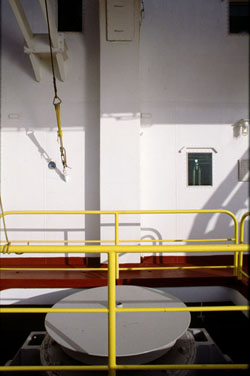Leg 169-Sedimentary Ridges II
| Co-Chiefs: Yves Fouquet and Robert
A. Zierenberg | Staff Scientist: Jay Miller |
| Cruise Dates: 22 August-17 October
1996 | Operations Superintendent: Eugene
Pollard
Engineer: Leon Holloway |
 As the second leg of a planned two-leg program (the first being Leg 139), Leg
169 will address a broad range of scientific problems. However, the major
emphasis of the leg is to investigate the genesis of massive sulfide deposits.
This project in the northeastern Pacific Ocean basin will be focused in two
ideal laboratories for investigating sediment-hosted massive sulfide deposits:
Middle Valley at the northern end of the Juan de Fuca Ridge, and Escanaba
Trough at the southern end of the Gorda Ridge. The four primary topics that
encompass the drilling strategy of this leg are (1) the mechanism of formation
of massive sulfide deposits at sediment-covered ridges, (2) the tectonics of
sedimented rifts and the controls on fluid flow, (3) the sedimentation history of
sedimentary rifts and their diagenesis, and (4) the extent and importance of
bacterial activity in these environments. These problems will be addressed by
drilling deposits of differing maturity and by drilling a series of holes across
deposits at each of the sites planned for Leg 169. By examining the sedimentary
record of hydrothermal products adjacent to the deposits, an attempt to
constrain the timing and duration of hydrothermal activity will be made.
Sampling of the alteration zones beneath the deposits will constrain the sources
of metals in the deposits and the geochemical reactions that control
mineralization. Opening sealed, instrumented boreholes in the Middle Valley
hydrothermal field will allow the first subsurface sampling of hydrothermal
fluids from an ODP borehole. In addition, it is intended to perform the first
active hole-to-hole hydrologic experiment designed to constrain the physical
and hydrologic properties that control hydrothermal flow on the scale of an
entire vent field.
As the second leg of a planned two-leg program (the first being Leg 139), Leg
169 will address a broad range of scientific problems. However, the major
emphasis of the leg is to investigate the genesis of massive sulfide deposits.
This project in the northeastern Pacific Ocean basin will be focused in two
ideal laboratories for investigating sediment-hosted massive sulfide deposits:
Middle Valley at the northern end of the Juan de Fuca Ridge, and Escanaba
Trough at the southern end of the Gorda Ridge. The four primary topics that
encompass the drilling strategy of this leg are (1) the mechanism of formation
of massive sulfide deposits at sediment-covered ridges, (2) the tectonics of
sedimented rifts and the controls on fluid flow, (3) the sedimentation history of
sedimentary rifts and their diagenesis, and (4) the extent and importance of
bacterial activity in these environments. These problems will be addressed by
drilling deposits of differing maturity and by drilling a series of holes across
deposits at each of the sites planned for Leg 169. By examining the sedimentary
record of hydrothermal products adjacent to the deposits, an attempt to
constrain the timing and duration of hydrothermal activity will be made.
Sampling of the alteration zones beneath the deposits will constrain the sources
of metals in the deposits and the geochemical reactions that control
mineralization. Opening sealed, instrumented boreholes in the Middle Valley
hydrothermal field will allow the first subsurface sampling of hydrothermal
fluids from an ODP borehole. In addition, it is intended to perform the first
active hole-to-hole hydrologic experiment designed to constrain the physical
and hydrologic properties that control hydrothermal flow on the scale of an
entire vent field.
Leg Objectives
The primary objectives of Leg 169 are to investigate the following areas:
Mechanism of formation of massive sulfide deposits at sediment-covered
ridges.
- Size and geometry of sulfide deposits and hydrothermal alteration zones;
- Compositional variations within and between deposits;
- Source of metals in massive sulfides;
- Constraints on fluid temperatures and compositions that deposited
massive sulfide;
- Composition of fluids in producing boreholes;
- Timing and duration of hydrothermal activity; and
- Formation of hydrothermal mounds in active vent fields.
Tectonics of sedimented rifts and controls on fluid flow.
- Controls on igneous activity at sedimented rifts and the importance of sill
emplacement;
- Permeability and structural controls on hydrothermal circulation;
- Interrelationship of faulting and fluid flow;
- Constraints for hydrologic modeling; and
- Factors controlling fluid flow on the scale of individual vent complexes
and the importance of sub-seafloor fluid mixing.
Sedimentation history and diagenesis at sedimented rifts.
- Source and deposition rate of sediments;
- Diagenetic reactions in a high heat-flow regime;
- Organic matter alteration and generation of hydrothermal petroleum;
- Extent and importance of bacterial activity;
- Role of bacteria in oxidation of organic matter, reduction of sulfate, and
precipitation of carbonate;
- Activity of thermophilic bacteria in sealed boreholes at known
temperatures and fluid compositions;
- Extent of thermophilic and nonthermophilic bacteria in the subsurface and
their relationship to hydrothermal fluid compositions; and
- Comparison of bacterial populations in active and inactive hydrothermal
deposits.
Operations Update
Participants aboard Leg 169 plan to unseal, log, sample borehole fluid and
reseal with an instrumented CORK from the two holes originally sealed and
instrumented on the first leg of this two-leg program (Leg 139). One of these
holes (Hole 857D) will be deepened before instrumentation.
The presence of instrumented boreholes allows active experimentation as well
as continued monitoring and sampling of hydrothermal fluids at ridge crests.
Our multidisciplinary approach, encompassing integrated geological,
geophysical, geochemical, hydrological, and biological investigations, ensures
the most productive yet economical exploration and utilization of these
exceptional natural laboratories.

To Semiannual Report Contents
To Program Updates, Leg Highlights Contents